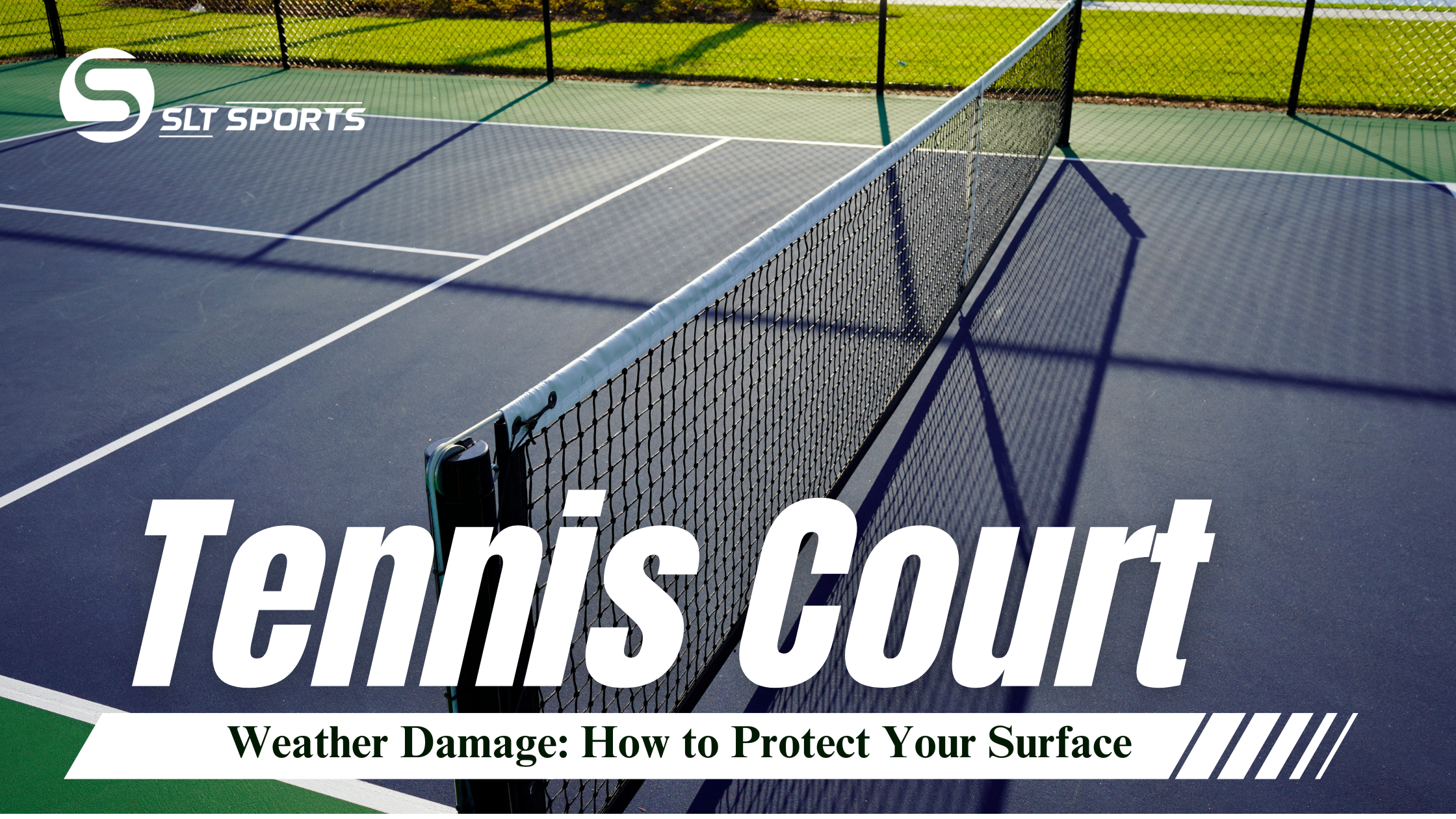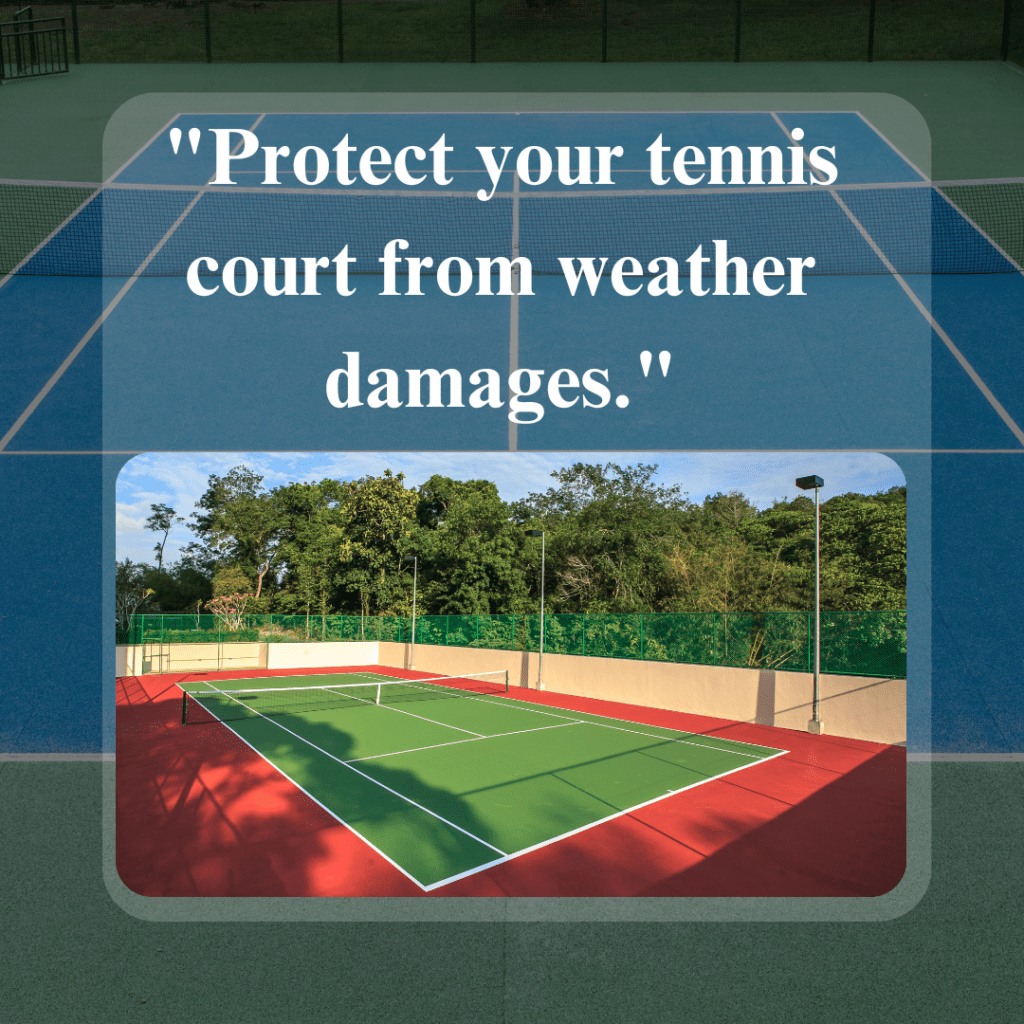
A well-maintained tennis court surface is crucial for performance and longevity. Outdoor courts are constantly exposed to weather, which can cause severe surface damage if not properly protected. Knowing how the weather affects your tennis court flooring and how to protect it will help keep it durable, playable and looking great for years to come.
At SLT Sports we specialize in high quality sports court installation for tennis court. In this guide we’ll look at the common weather related damages to tennis courts and how to prevent them.
Common Weather-Related Damages to Tennis Court Surface
1. Temperature Fluctuation Cracking
The courts also expand and contract as a result of extremely high temperature changes. The surface expands during summer seasons and upon cold weather, the surface contracts and cracks after some time. The cracks not only affect the surface appearance of the court but also the functioning and the safety of the players. Temperature fluctuations are known to accelerate the degradation of the flooring on tennis courts so that it ends up being brittle and not very shock absorbent. It is thus very important to use top-notch materials that can withstand fluctuating climatic conditions.
2. UV Radiation and Surface Fading
Regular sun exposure can make the surface and line color of the tennis court lose its vibrancy. UV sunlight splits the binder chemicals in synthetic materials that render the surface brittle and wear out faster. Discolored lines and tennis court surfaces over time can reduce visibility and affect the play. Invest in UV resistant coatings and resurfacing from expert tennis court resurfacing companies near me to prevent early wear.
3. Water Pooling and Drainage Issues
Undrained water may create puddles that make the court slippery and hazardous. Water may penetrate into cracks and spread damage upon freezing and thawing. Poor drainage can also result in algae and mold development making the surface hazardous. Good drainage system is essential in prevention of long term problems.
4. Heavy Rain and Surface Wear
Poorly built tennis court surfaces wear out quickly in heavy rain. Water runoff erodes the top layer, making play unsafe and repairs expensive. Repairing such damage will be costly since it will take the form of resurfacing or rebuilding the court. In order to prevent erosion, local professional tennis court installation services ensure courts are appropriately constructed with a proper slope and high-quality materials that can be resistant to water damage.
5. Damage from Snow and Ice
Snow and ice in cold climates can aggravate cracks and make the surface more slippery. Inappropriate removal techniques such as metal shovels or salt-based deicers can further damage the surface. Ice expansion is to blame for deep cracks that raise the repair cost.

How to Protect Your Tennis Court from Weather Damage
1. Choose High-Quality Tennis Court Floor Materials
Choosing the best material by a highly ranked tennis court floor material supplier provides better protection against extreme weather conditions. At SLT Sports, we provide high-performance acrylic, synthetic, and cushioned surfacing that is resistant to environmental stress. Spending on durable material saves repair cost in the long term and enhances court life.
2. Offer Appropriate Drainage System
An efficient drainage system planned correctly will prevent water accumulation. When getting a tennis court installed, make sure that the court has a slight slope for proper drainage. Engaging the services of near-me tennis court installation professionals will help install a successful drainage plan. Perimeter drains, porous bases, and grade adjustments will enhance drainage performance.
3. Regular Resurfacing and Repairing
Tennis court resurfacing companies can restore older surfaces and increase their lifespan. Resurfacing every 4-8 years provides the top appearance for a court by halting cracks and surface wear and tear. Resurfacing includes filling small cracks, applying fresh coats, and putting in fresh lines of a tennis court. Multiple resurfacing not only keeps the court in top form but also insures safe conditions to play in.
4. UV Protection and Color Coating
UV-resistant coating of the court maintains the court’s color and strength and keeps the court from losing color and strength. Acrylic coatings, besides hardening the surface, also enhance traction and consistency in ball bounce. The coatings are made to resist surface degradation upon sun exposure over prolonged periods and to keep courts colorfully bright.
5. Correct Winterization Procedures
If you live in an area with extreme winters, then you need to winterize your court correctly. Snowplowing with non-abrasive equipment, protective sealants, and professional covers will save you from causing damage in the long term. Avoid using chemicals, and hire professionals to prepare your court for winter as part of a tennis court maintenance service to minimize damage to the surface.
6. Routine Maintenance and Cleaning
Routinely cleaning out debris, draining water that stands, and performing crack checks will prevent minor issues from snowballing. Professional tennis court repair service ensures professional checks and rapid repairs. Power washing, sealing cracks, and repainting lines on the tennis court routinely may prolong the life of the court by years.
7. Strategic Court Placement
Positioning the court to receive limited direct sunlight and wind exposure while being installed will reduce wear and tear. Trees or windbreaks over the course of the court can provide natural cover. Proper positioning reduces the impact of extreme temperatures and reduces exposure to environmental stress factors.
The Cost of Weather Damage and Long-Term Savings
Failure to maintain weather conditions can lead to expensive repairs. The cost of resurfacing or rebuilding a synthetic acrylic tennis court can be extremely expensive compared to regular maintenance. Protective coatings and repairing small cracks are much cheaper than major repairs. Professional inspections and resurfacing services can save money in the long run and avoid surprise expenses.
Tennis court flooring is built to withstand, but with no maintenance, even the finest materials can fall apart. Resurfacing a court can cost anywhere from a few thousand dollars to much, much more, depending on how much damage. Tennis court construction services in my area can give estimates and maintenance schedules that assist owners in budgeting for long-term court maintenance.
Conclusion
Weather damage is one of the largest threats to the lifespan and play of your tennis court surface. With the selection of good-quality tennis court flooring, proper drainage, protective coating, and routine maintenance, you are able to greatly increase the life of your court. Preventive care eliminates the possibility of extensive damage and maintains a top-quality playing surface year-round.
If you’re searching for professional advice on tennis court construction companies near me or require professional resurfacing and repairs, SLT Sports can assist you. With years of experience in the industry, we are experts at delivering long-lasting, high-performance sports surfaces for a range of facilities.
Need help protecting your tennis court surface? Call SLT Sports today or expert installation, maintenance, and resurfacing solutions that last.
Frequently Asked Questions
Synthetic courts employ man-made surfaces, are less maintenance than grass or clay, are weather resistant, and can be regulated for speed and comfort.
Tennis courts differ by surface: acrylic flooring, artificial turf, sports interlocking tiles, PVC vinyl flooring, as well as traditional clay, grass, and concrete.
Synthetic acrylic flooring is also very resistant to wear because of its hard top, but interlocking tiles and artificial turf resist wear outside tennis court surface.
They are resistant to UV degradation, dry out quickly after rain, and also withstand heat shocks well, but require good drainage to avoid water problems.
4–8 weeks: duration of construction, including site preparation (1–2 weeks), foundation work (1–2 weeks), layering of surfacing (1–2 weeks), and finishing work (a few days).

